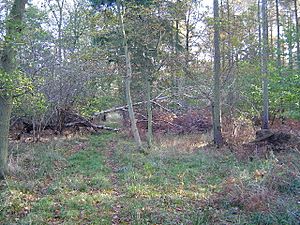Collyweston Great Wood and Easton Hornstocks facts for kids
| Site of Special Scientific Interest | |
 |
|
| Area of Search | Northamptonshire |
|---|---|
| Interest | Biological |
| Area | 151.5 hectares |
| Notification | 1984 |
| Location map | Magic Map |
Collyweston Great Wood and Easton Hornstocks is a really special place for nature. It's a huge area of woodland, about 151.5 hectares, located north of King's Cliffe in Northamptonshire. This site is so important that it has two special titles: a Site of Special Scientific Interest (SSSI) and a National Nature Reserve.
Being a National Nature Reserve means it's one of the best places in the country for wildlife and natural features. It's also listed as a Grade I site in the Nature Conservation Review, which means it's super important for protecting nature. The woods are about 14 kilometres (8.7 mi) west of Peterborough. The villages closest to the site are Collyweston, about 1 kilometre (0.62 mi) to the north-west, and Duddington, a similar distance to the west.
Amazing Wildlife and Plants
These woods are home to many different kinds of trees. You'll find ash, lime, and sessile oak trees here. There's also a special tree called the wild service-tree. Finding this tree is a sign that the woodland is very old, perhaps hundreds of years old!
The ground beneath the trees is full of interesting plants. Some of these are quite rare in the local area. Look out for beautiful flowers like lily-of-the-valley, wood spurge, great wood-rush, violet helleborine, and columbine.
The woods are also a great place for animals. You might spot a slowworm, which is a type of legless lizard. Birds of prey like the red kite and common buzzard fly overhead. And if you listen carefully, you might hear the drumming of lesser spotted woodpeckers and great spotted woodpeckers.
A Glimpse into History
Long ago, these woods were part of a much bigger forest called Rockingham Forest. They used to be connected to another large woodland area called Bedford Purlieus. This connection lasted until the mid-1800s.
Over time, parts of the woods were changed by people. For example, some areas in Easton Hornstocks were dug up for quarrying. Also, a section within Collyweston Great Wood was cleared of trees to build RAF Collyweston, which was an air force base.
If you want to visit this special place, you usually need permission. You can get a permit from Natural England, which is an organization that helps protect nature in England.
Uncovering Roman Secrets
In the autumn of 1953, something amazing was found in Collyweston Wood. Contractors working at an old Royal Air Force bomb site discovered a large Roman settlement! They found lots of old stones and pieces of pottery.
Archaeologists then started digging to learn more. They found the corner of a rectangular building. After telling the chief inspector of ancient monuments, a bigger excavation began in October 1953. This month-long dig uncovered a fantastic group of buildings.
These buildings had walls made of dry stone (meaning no cement was used). They included two rectangular buildings, a circular building, an octagonal building (with eight sides), and a hexagonal building (with six sides). Experts believe these were the remains of several Roman temples and other buildings used with them.
The archaeologists also found many pieces of pottery. Some large bowls had cool designs, like dolphins and sea horses! These pottery pieces were made locally. They also discovered beautiful jewelry, including decorated brooches and pins. The pottery found shows that people lived and used this site from the 1st to the early 4th centuries of the Common Era.

